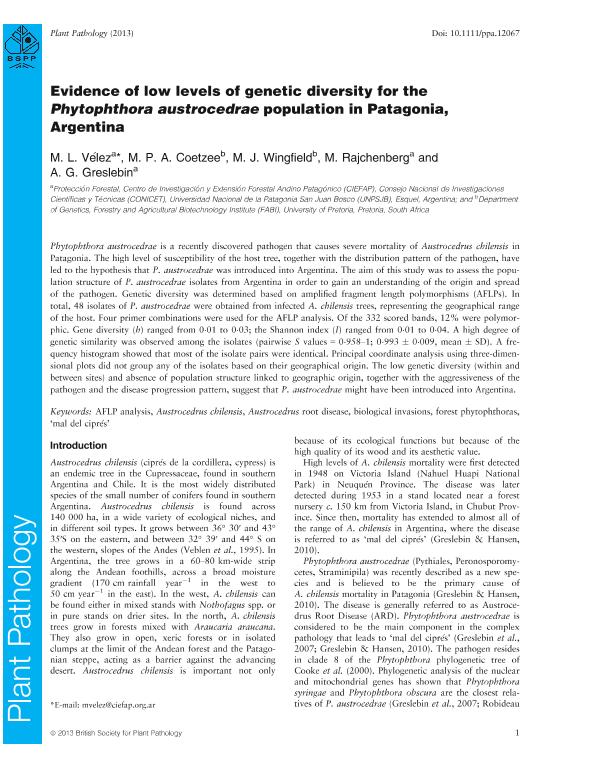Artículo
Evidence of low levels of genetic diversity for the Phytophthora austrocedrae population in Patagonia, Argentina
Velez, Maria Laura ; Coetzee, M. P. A.; Wingfield, M. J.; Rajchenberg, Mario
; Coetzee, M. P. A.; Wingfield, M. J.; Rajchenberg, Mario ; Greslebin, Alina Gabriela
; Greslebin, Alina Gabriela
 ; Coetzee, M. P. A.; Wingfield, M. J.; Rajchenberg, Mario
; Coetzee, M. P. A.; Wingfield, M. J.; Rajchenberg, Mario ; Greslebin, Alina Gabriela
; Greslebin, Alina Gabriela
Fecha de publicación:
27/02/2014
Editorial:
Wiley
Revista:
Plant Pathology
ISSN:
0032-0862
Idioma:
Inglés
Tipo de recurso:
Artículo publicado
Clasificación temática:
Resumen
Phytophthora austrocedrae is a recently discovered pathogen that causes severe mortality of Austrocedrus chilensis in Patagonia. The high level of susceptibility of the host tree, together with the distribution pattern of the pathogen, have led to the hypothesis that P. austrocedrae was introduced into Argentina. The aim of this study was to assess the population structure of P. austrocedrae isolates from Argentina in order to gain an understanding of the origin and spread of the pathogen. Genetic diversity was determined based on amplified fragment length polymorphisms (AFLPs). In total, 48 isolates of P. austrocedrae were obtained from infected A. chilensis trees, representing the geographical range of the host. Four primer combinations were used for the AFLP analysis. Of the 332 scored bands, 12% were polymorphic. Gene diversity (h) ranged from 0·01 to 0·03; the Shannon index (I) ranged from 0·01 to 0·04. A high degree of genetic similarity was observed among the isolates (pairwise S values = 0·958–1; 0·993 ± 0·009, mean ± SD). A frequency histogram showed that most of the isolate pairs were identical. Principal coordinate analysis using three-dimensional plots did not group any of the isolates based on their geographical origin. The low genetic diversity (within and between sites) and absence of population structure linked to geographic origin, together with the aggressiveness of the pathogen and the disease progression pattern, suggest that P. austrocedrae might have been introduced into Argentina.
Archivos asociados
Licencia
Identificadores
Colecciones
Articulos(CCT-CENPAT)
Articulos de CTRO.CIENTIFICO TECNOL.CONICET - CENPAT
Articulos de CTRO.CIENTIFICO TECNOL.CONICET - CENPAT
Citación
Velez, Maria Laura; Coetzee, M. P. A.; Wingfield, M. J.; Rajchenberg, Mario; Greslebin, Alina Gabriela; Evidence of low levels of genetic diversity for the Phytophthora austrocedrae population in Patagonia, Argentina; Wiley; Plant Pathology; 63; 1; 27-2-2014; 212-220
Compartir
Altmétricas



